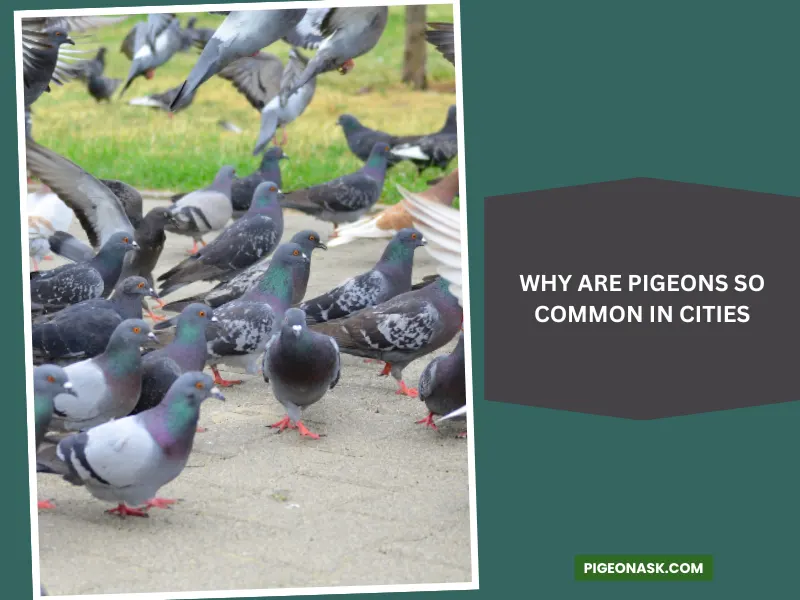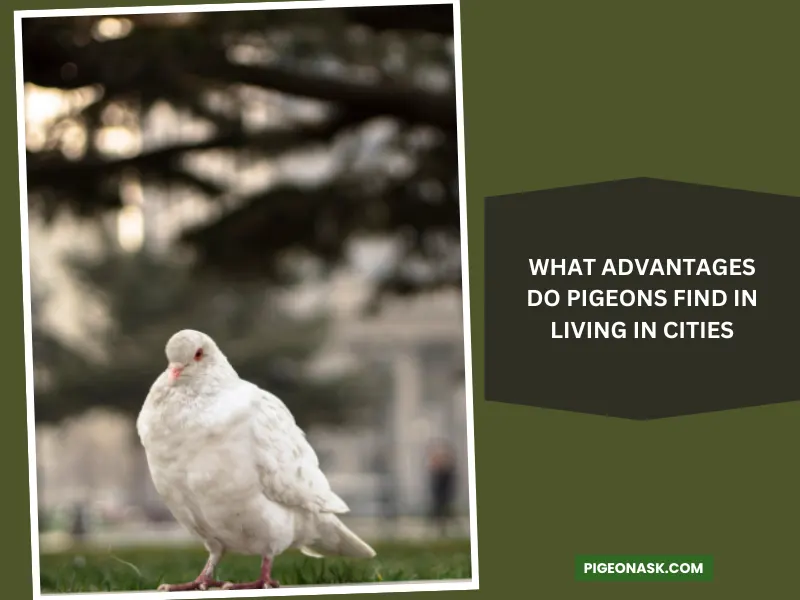Why Do Pigeons Live In Big Cities?
Pigeons sitting and flying around in the cities are quite common scenes. I’m sure, like most other city-dwellers, you’ve also found yourself wondering how they really ended up here; why do pigeons live in big cities?
Well, you might not know, but pigeons are quite fond of solid surfaces and infrastructure, which made them move to cities. However, their interest in cities did not grow overnight. There’s an incredible background story and we’re about to disclose it in our article.
So, stay with the till the end to explore the history and facts that caused pigeons to choose the city.
Looking for more articles about pigeon habitat:
Do All Pigeons Live in Cities?
Pigeons are not too different from humans, especially when it comes to the reasons they choose cities over rural countryside. And just like humans, not all pigeons choose to live in cities.

The pigeons we often get to see in cities are feral pigeons. They are the descendant of a wilder breed called the rock dove (Columba livia).
These feral pigeons have been seen to adapt quite well to different kinds of environments and habitats alongside the cities.
This includes rural places, farmlands, coastal cliffs, forests, and several other regions. However, the number of pigeons in the cities is much higher than most other regions.
You can read our article about “Pigeon Habitat“
How Did Pigeons Adapt to the City?
The wild rock doves lived on rocky coastal cliffs. The descendant of these wild rock doves found the architectural infrastructure quite similar to the cliffs their ancestors used to live on. And so this is what made adapting to the city easier for them.

Other than that, there are several ways in which the pigeons have developed adaptability within themselves, as follows –
01. Tolerance to human presence:
The biggest move towards city adaptation by the pigeons is becoming accustomed to and comfortable around humans.
They have an incredible level of tolerance for human presence, noise, and movement. And they easily navigate crowded streets, bustling squares, and other urban environments without being unduly alarmed or deterred.
02. Nesting within Infrastructure:
Pigeons have adapted to the man-made structures found in cities by utilizing them as nesting sites.
Numerous nooks, ledges, and crevices in buildings, bridges, and other urban infrastructure are suitable nesting spots for pigeons.
These elevated locations provide safety from ground-level predators and more exposure to the sky, just like rock cliffs used to do for wild doves.
03. Food Adoption:
Pigeons are opportunistic feeders and have adapted to utilize various food sources available in cities. They have a diverse diet that includes seeds, grains, fruits, insects, and even human food waste.
Urban environments provide pigeons with an abundance of food options, such as discarded food in public spaces, open garbage containers, and bird feeders.
04. Navigational Abilities:
Pigeons possess exceptional navigational skills. They are speculated to have an internal “magnetic compass.” It helps them to sense the magnetic field of the Earth and use it for navigation.
This innate ability they have helps them find their way back to roosting sites along with exploring new areas within the urban landscape.
Why Are Pigeons So Common in Cities?
Ever wondered, why so many cities have so many pigeons? This is because of an underrated trait of the pigeons to prefer hard surfaces for their dwelling.

Their ancestors were named “Rock Doves” for a reason. They are fond of making their nests on rock-hard surfaces. This includes the concrete or marble surfaces of the cities.
So, while most other birds build nests in trees and bushes, they look for places with stronger and harder surfaces. Moreover, they also prefer their nests at a bit of a height to ensure safety from land predators.
And most naturally, harder and higher surfaces like cliffs come with several disadvantages, including not having enough food sources. Thus, cities are the ideal choice for them.
History of Pigeon Migration
The migration of pigeons has a quite fascinating story behind it that takes us thousands of years back. Mainly, the rock doves originated in Europe, North Africa, and parts of Asia.

They usually have a very deep connection with human civilizations and have come across several human-assisted migrations that led their presence to several other regions of the world, far from their origins.
Early Migratory Patterns of Pigeons
Ancient rock doves are known to bear natural migratory behavior. They usually migrate from one region to another in search of food or suitable nesting spots.
Initially, these migrations used to be within Europe, North Africa, and Asia – their native range. However, rock doves were adept flyers, capable of covering long distances during their migratory journeys.
Despite that, they have been kept by humans for a long time, since about 5,000 years from now. Also, they have been merchandised within various countries from the very beginning as a means of trade.
So, they travel across the borders, reaching all different corners of the world, including Europe, North America, South America, Australia, and many parts of Asia.
They have been selectively bred by humans for years to fulfill several purposes. This includes using them as messengers, pets, and as a source of food.
Over time, some domesticated pigeons escaped or were intentionally released, leading to the creation of feral populations in different regions.
How Cities Became Attractive to Pigeons
The migratory patterns of the pigeons were significantly influenced once they started living in the cities. Because they no longer needed to travel long distances for food and nest like their wilder counterparts.
They gradually became more sedentary due to the lavish urban lifestyle, which limited their movement and migratory behavior.
This is how the feral pigeons grew apart from the wilder forms of rock doves and chose to live in cities for the wider availability of survival elements that a city lifestyle provides them with.
What Advantages Do Pigeons Find in Living in Cities
A significant reason for the pigeons to select the city over all other regions is the huge number of advantages they receive inside the city. The following are a few notables among them –

01. Food Sources
As said before, cities offer a diverse range of food options for pigeons. This includes discarded human food, open garbage containers, and bird feeders.
The availability and abundance of food in such close proximity to their dwelling sites reduce the effort required for pigeons to meet their nutritional needs, making urban areas extremely attractive to them.
02. Nesting Locations
Cities provide pigeons with ample roosting and nesting sites. As discussed a while ago, pigeons typically build nests on well-protected solid surfaces.
And so, urban places such as building ledges, rooftops, and bridges are suitable choices for them. These structures offer an array of crevices and ledges that serve as excellent nesting spots for the pigeons.
These locations are also elevated from the ground, which provides the pigeons with safety from predators and natural elements, contributing to their survival and reproduction.
03. Lack of Natural Predators
Compared to rural areas, the absence of natural predators ensures better security for the pigeons in the cities. Locations around the country side usually contain several predators, like birds of prey and mammals.
They pose a threat to pigeons and cause constant insecurity within. However, cities often lack such predators.
The abundance of human activity and infrastructure in urban environments limits the presence of these natural predators, providing pigeons with a safer habitat.
04. Climate and Weather Conditions
The weather in a city is much different from its nearby rural areas. It’s much warmer than the rural sites due to the increased heat absorption and retention caused by the concentration of buildings, asphalt, and human activities.
This attracts the pigeons towards the city, as most of the higher solid nesting spots in other regions usually have colder weather. Moreover, cities also provide enough shelter from extreme weather like storms or snow.
Besides, cities also have very little seasonal variability. For this reason, the pigeons don’t require much effort to prepare themselves for the season change in these areas.
05. Feeding and Caring for Pigeons
Cities are filled with occasional pigeon feeders and hobbyists. They are fond of feeding the pigeons specialized pigeon foods and take care of them at their leisure. Pigeons take advantage of their love and get pampered for free.
These occasional pigeon enthusiasts are not present everywhere. But in cities, you will always find someone in every location looking after the pigeons without asking for anything in return.
So, why wouldn’t the pigeons want to enjoy these conveniences of city life?
Frequently Asked Questions
1. Why does NYC have so many pigeons?
Pigeons love New York City for the advantages it offers them, which include food availability, large population, and high-rise infrastructure. And so, it’s a popular choice for most pigeons for convenient survival.
2. What city has the most pigeons?
New York City have been seen with the most number of pigeons compared to other cities in the United States. It’s a city perfect for the lives of feral pigeons. And so it has a pigeon density of about 3 pigeons per human.
3. Where do pigeons live in the US?
Pigeons are capable of living pretty much in any environment. However, in the cities of the US, you will often see them dwelling in parks, buildings, bridges, and other concrete structures. And in the countryside, they often build nests in feed mills, farm yards, and grain elevators.
Final Words
The rich history that led the pigeons to end up in some of the largest and busiest cities in different parts of the world is quite intriguing right? Thanks for your interest.
Hope we were able to cover everything you wanted to know about why do pigeons live in big cities.
But wait. Knowing something new but not sharing it with your besties would be a crime. So, just go on and share this article with all your pigeon-loving friends on Facebook, Twitter, and Pinterest.
Image Credit:
- Canva.com/photos
Reference Links:
- https://www.theguardian.com/notesandqueries/query/0,,-69324,00.html
- https://www.ovocontrol.com/pigeon-facts-figures
- https://www.northcountrypublicradio.org/news/story/16494/20210819/natural-selections-why-pigeons-feel-at-home-in-the-city
